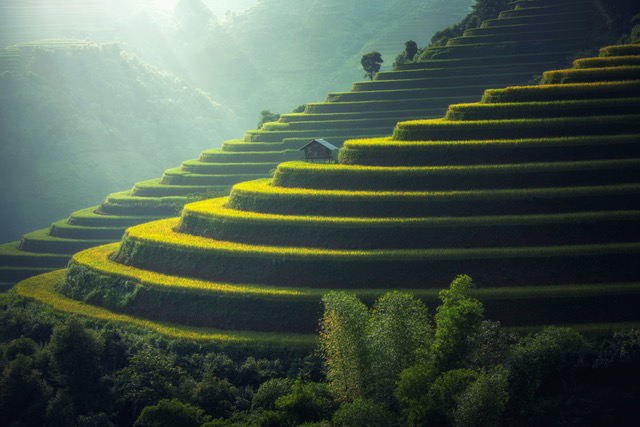 February 7, 2019 - By Brian David (U.C. Master Gardener, Mariposa) - California’s Mediterranean climate of short, wet winters and long, dry summers sustains more diverse foliage in California than any other of the forty-nine states. For California’s commercial agriculture and home gardening, however, capturing water is crucial. We channel surface runoff from watersheds, diverting water into reservoirs and dams and direct the flow and delivery of water through aqueducts and canals. We tap into underground water systems through wells.
February 7, 2019 - By Brian David (U.C. Master Gardener, Mariposa) - California’s Mediterranean climate of short, wet winters and long, dry summers sustains more diverse foliage in California than any other of the forty-nine states. For California’s commercial agriculture and home gardening, however, capturing water is crucial. We channel surface runoff from watersheds, diverting water into reservoirs and dams and direct the flow and delivery of water through aqueducts and canals. We tap into underground water systems through wells.
The majestic Sierra Nevada Range delivers 60% of California’s fresh surface water with the remaining 40% coming from underground aquifers. Homeowners use municipal water systems, wells or capture and store water in above ground tanks, underground cisterns, rain barrels or ponds. There are other less expensive ways to capture and save rain for a dry day.
Terraces are short walls on hillsides that create flat land areas, slowing and stabilizing water runoff. They are like giant steps moving up and down a hillside and have an ancient success rate for capturing water and growing crops. Terraces need to follow the natural contour of the hillside (a terrace can be laid out using an A-Frame Level to determine an even contour). Terraces should have an accessible area to bring in equipment and tools for planting, harvesting and soil management.
Rock or masonry are good materials to use for terracing because of their strength, longevity and thermodynamics. Wood can ensure a terraced wall is secure and will not give way to flooding or landslides. A terrace can transform a south facing slope into a perfect growing area. The down side of terracing is the initial labor and capital necessary. A simpler solution for catching water runoff on a slope is to build berms. A berm is a raised area that will slow or stop the water running off on a hillside. A well-laid berm can hold water long enough for water to begin percolating down into the soil. The berm should be carefully placed into the hillside, so it does not create a stream, eroding the downside of the hill. Berm’s “slow, spread and sink” the water running off the top of a surface so water percolates down into the soil. A berm can be a planted dirt mound, or a log covered with soil and organic matter to prevent erosion.
A simpler solution for catching water runoff on a slope is to build berms. A berm is a raised area that will slow or stop the water running off on a hillside. A well-laid berm can hold water long enough for water to begin percolating down into the soil. The berm should be carefully placed into the hillside, so it does not create a stream, eroding the downside of the hill. Berm’s “slow, spread and sink” the water running off the top of a surface so water percolates down into the soil. A berm can be a planted dirt mound, or a log covered with soil and organic matter to prevent erosion.
The counterpart of a berm is a swale. A swale is a trench, with a level bed dug along the hill’s contour. A swale (like a terrace) can be designed to follow the level contour along the hillside by using an A- Frame Level. A manageable swale for a home is from six to twelve inches deep and twice as wide. The swale can be back filled with a layer of sand and/or gravel on the bottom covered by decaying wood, blanketed with dried leaves or straw, then finished off with top soil. The leftover dirt from digging the swale will form the berm on the downward side of the swale. The berm can be seeded with fast-growing grass or legumes. The berm should slow the water, allowing it to back up over the swale. The swale speeds the rate and deepens the storage of water seeping into the soil. Planting into your berm provides additional moisture and nutrients for plants. Unlike terraces, swales should be staggered up a hillside, or overflow depressions should be built into their berms, to avoid erosion.
I hope you capture some water this rainy season to save for drier days.
The U.C. Master Gardener Helpline is staffed; Thursdays from 2:00 p.m. - 5:00 p.m.
Please contact the helpline, or leave a message by phone at: (209) 966-7078
By email (send photos and questions for researched answers) to: mgmariposa@ucdavis.edu
Visit our UCMG website: http://cemariposa.ucanr.edu/Master_Gardener
Follow us on Facebook at: https://www.facebook.com/mariposamastergardeners
Master Gardener Office Location:
UC Cooperative Extension Office,
5009 Fairgrounds Road
Mariposa, CA 95338
Phone: (209) 966-2417
Email: mgmariposa@ucdavis.edu
Website: http://cemariposa.ucanr.edu/Master_Gardener








